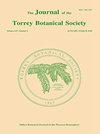Forest understory vegetation along a productivity gradient1
IF 0.8
4区 生物学
Q4 PLANT SCIENCES
引用次数: 18
Abstract
these communities. We examined vegetation structure and species distribution patterns in the forest understory community of two topographically similar watersheds to evaluate the predicted roles of abiotic limitation and competition along a productivity gradient. Canonical correspondence analysis identified a dominant compositional gradient that was strongly correlated with moisture, light, and herbaceous-layer cover. Given these relationships, the first axis of the ordination was taken as a reliable index of productivity. Contrary to expectation, species richness increased monotonically along the gradient rather than reaching a maximum and then declining which suggests that species are not excluded by light competition at the high-productivity end of the gradient. Other vegetation patterns, however, indicated both abiotic limitation in regions of low productivity and competition at high productivity. Patterns in species' distributions also suggested resource limitation at low productivity, but they showed mixed evidence of competition at high productivity. Taken together, these patterns in vegetation structure and species' distributions imply that while competition may occur among herbaceous-layer species, particularly at high productivity, competitive exclusion remains low. This may be because the traits that permit survival under tree canopy shading reduce the effects of light competition with other understory species, or because understory productivity is not high enough to induce intense light competition among herbaceouslayer species.森林林下植被沿生产力梯度
这些社区。研究了两个地形相似流域林下植被群落的植被结构和物种分布格局,以评价非生物限制和竞争在生产力梯度上的预测作用。典型对应分析确定了一个与水分、光照和草本层覆盖密切相关的主要成分梯度。鉴于这些关系,排序的第一个轴被认为是一个可靠的生产率指标。与预期相反,物种丰富度沿梯度单调增加,而不是达到最大值然后下降,这表明物种在梯度高生产力端没有被光竞争排除在外。而其他植被格局则显示出低生产力区域的非生物限制和高生产力区域的竞争。物种分布模式也表明在低生产力时资源有限,但在高生产力时表现出竞争的混合证据。综上所述,这些植被结构和物种分布模式表明,尽管草本层物种之间可能存在竞争,特别是在高生产力的情况下,但竞争排斥仍然很低。这可能是因为允许在树冠遮荫下生存的性状减少了与其他林下物种的光竞争的影响,或者是因为林下生产力不够高,不足以引起草本层物种之间激烈的光竞争。
本文章由计算机程序翻译,如有差异,请以英文原文为准。
求助全文
约1分钟内获得全文
求助全文
来源期刊
CiteScore
0.70
自引率
0.00%
发文量
16
审稿时长
>12 weeks
期刊介绍:
The Journal of the Torrey Botanical Society (until 1997 the Bulletin of the Torrey Botanical Club), the oldest botanical journal in the Americas, has as its primary goal the dissemination of scientific knowledge about plants (including thallopyhtes and fungi). It publishes basic research in all areas of plant biology, except horticulture, with an emphasis on research done in, and about plants of, the Western Hemisphere.

 求助内容:
求助内容: 应助结果提醒方式:
应助结果提醒方式:


